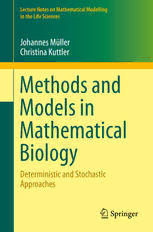Table Of ContentLecture Notes on Mathematical Modelling
in the Life Sciences
Johannes Müller
Christina Kuttler
Methods and
Models in
Mathematical
Biology
Deterministic and Stochastic
Approaches
Lecture Notes on Mathematical Modelling
in the Life Sciences
SeriesEditors
AngelaStevens
MichaelC.Mackey
Moreinformationaboutthisseriesat
http://www.springer.com/series/10049
Johannes MuRller • Christina Kuttler
Methods and Models
in Mathematical Biology
Deterministic and Stochastic Approaches
123
JohannesMuRller ChristinaKuttler
CentreforMathematicalSciences CentreforMathematicalSciences
TechnicalUniversityMunich TechnicalUniversityMunich
Garching,Germany Garching,Germany
ISSN2193-4789 ISSN2193-4797 (electronic)
LectureNotesonMathematicalModellingintheLifeSciences
ISBN978-3-642-27250-9 ISBN978-3-642-27251-6 (eBook)
DOI10.1007/978-3-642-27251-6
LibraryofCongressControlNumber:2015945816
SpringerHeidelbergNewYorkDordrechtLondon
©Springer-VerlagBerlinHeidelberg2015
Thisworkissubjecttocopyright.AllrightsarereservedbythePublisher,whetherthewholeorpartof
thematerialisconcerned,specificallytherightsoftranslation,reprinting,reuseofillustrations,recitation,
broadcasting,reproductiononmicrofilmsorinanyotherphysicalway,andtransmissionorinformation
storageandretrieval,electronicadaptation,computersoftware,orbysimilarordissimilarmethodology
nowknownorhereafterdeveloped.
Theuseofgeneraldescriptivenames,registerednames,trademarks,servicemarks,etc.inthispublication
doesnotimply,evenintheabsenceofaspecificstatement,thatsuchnamesareexemptfromtherelevant
protectivelawsandregulationsandthereforefreeforgeneraluse.
Thepublisher,theauthorsandtheeditorsaresafetoassumethattheadviceandinformationinthisbook
arebelievedtobetrueandaccurateatthedateofpublication.Neitherthepublishernortheauthorsor
theeditorsgiveawarranty,expressorimplied,withrespecttothematerialcontainedhereinorforany
errorsoromissionsthatmayhavebeenmade.
Printedonacid-freepaper
Springer-Verlag GmbH Berlin Heidelberg is part of Springer Science+Business Media
(www.springer.com)
Foreword
Mathematical biology is in the moment a prosperous and exciting field. New
experimental methods require more and refined models. While experimental data
of traditional experiments often reflect an (population) average (like an average
protein level), more and more sophisticated experiments are able to characterise
single objects like cells, sometimes even single proteins. We begin to understand
that populationsare heterogeneous,that, e.g. even bacteria form a complex world
ofinteractingindividuals.Thisnewqualityindataandperceptionformschallenges
that are to be met and, correspondingly,a new quality in models is required. We
need to think about the classical approaches: Where are classical models still an
appropriate tool? Where do we need to extend them? Where are completely new
ideasnecessary?
To meet these challenges, a master class “Mathematics in Bioscience” has
beenimplementedattheTUMünchen.Studentsofmathematicsandneighbouring
disciplinesareeducatedinthissubject.Thisbookwasinspiredbyvariouscourses
the authors developed for this master class. In particular, the core of the book is
baseduponatwo-semesterclassinmathematicalmodellingofbiologicalsystems.
Thecontentsofthisbooksurelyreflectthepersonalviewandthepersonallikes
anddislikesoftheauthors.Acompleteoverviewofthefieldisneitherreachablenor
envisaged.Theaimisapresentationofandanintroductioninthe(atleastaccording
totheauthors’view)mostimportantandexemplarybasicmodelsandmethodsused
inmathematicalbiology,supplementedbysome non-standard,currenttopics.The
bookislargelyself-contained,andcentralmathematicalconceptsasdynamicalsys-
tems, stochastic processes, or discrete mathematicsare introduced.The emphasis,
however,isalwaysplacedontheapplicationsinlifesciencesandthediscussionof
differentmodellingapproaches.
Munich,Germany JohannesMüller
April2014 ChristinaKuttler
v
Directions for Use
Thisbookemergedfromseverallecturesaboutmathematicalbiology.Thecentre-
pieceoftheselecturesistheintroductionintomodelling,thetechniquestoanalyse
thesemodels,andthecontributionofthisanalysistoourunderstandingofbiology.
Itisnotnecessarytoreadallchaptersoneaftertheother,butmostchaptersdepend
onlyonveryfewearlierchapters,asdepictedinthefigurebelow.
Chapter 1 is different in character from all other chapters: it is focused on
methods and not on applications. There, we learn the basic techniques for linear
ordinary differential equations, linear stochastic differential equations, Markov
chains,andstochasticprocessesdescribingindependentparticles.Thesetechniques
are always introduced on the basis of biological examples, but the examples are
taken from several fields of biology.Models that deal with interacting individuals
(cooperation, competition, gene regulatory pathways, etc.) are investigated later.
However, also the techniques used for those nonlinear models are based on the
methodsforlinearsystemsdevelopedhere.
We think that the principles of interactions can be best introduced by means
of ecological examples. Chapter 2 gives some overview of the most important
ecologicalmodels.Toolstodealwiththesenonlinearmodels,e.g.bifurcationtheory
orthetimetoextinction,arealsoformulatedinthischapter.Chapters1and2form
thebackboneofthebook–theyestablishthelinearaswellasthenonlineartheoryof
compartmentalmodellingandpresenttheclassicalresultsofmathematicalbiology
inecology.Mathematicalecologyisnotonlyaninterestingtopicinitselfbutserves
asaprototype.Thequestionsdiscussedherewillreappearandarevariedalsointhe
otherfieldsofmathematicalbiology.
Equippedwiththesetechniques,itispossibletoreadthepartabouttheunstruc-
turedepidemiology(whichisstrictlyspokenpartofecology–hostsandpathogens
formanecosystem).Alsothepartaboutbiochemicalreactions,e.g.enzymekinetics,
or the emergingfield of gene regulatorynetworks, can be understoodbased upon
Chaps.1and2.
A new quality of models comes in with structure: The handling of space,
size, and age requiresadditionalideas. We againdevelopthese ideasprimarilyby
considerationsthatoccurinecologicalcontext(Chap.3).Applicationsinepidemics
vii
viii DirectionsforUse
(age structure) can be found in Sect.4.3, while applications for reactions (spatial
structure)aregiveninSect.5.4.
Thediscussionofevolutionisverymuchfocusedontheonehandonsomebasic,
classical models as the Fisher-Wright-Haldane model, and on the other hand on
adaptive dynamics. The tools needed here are rather special. Therefore, this short
chapteronlyrequiresprerequisitesdevelopedinChap.1.
Dependenciesofthebook’schapters
A word at the end: the difficulty of the topics changes from page to page.
Rather abstract and involving passages are followed by simple ones. Biological
examples, mathematical theory, and explicit calculations alternate. If you have
serious difficulties in understanding a certain passage, just skip it and proceed.
PerhapseveryonewhodealtwithmathematicsexperienceswhatJohnvonNeumann
expressed in the witticism “In mathematics you don’tunderstandthings. You just
getusedtothem”.Thetheorywillbeused,examplesdiscussed,andstepbystepthe
practicalimplicationsofdifficultpartsbecomeclear.Lateryoumayreturn,andyou
willfindthatwhatwasincomprehensiblebeforeisquitenaturallater.
Wehopeyouenjoyreadingthisbook!
Contents
1 CompartmentalModelling.................................................. 1
1.1 DeathProcess ........................................................... 2
1.1.1 SurvivalofOneIndividual.................................... 2
1.1.2 LevelofSmallPopulations ................................... 9
1.1.3 MediumPopulationSize...................................... 17
1.1.4 LargePopulations............................................. 28
1.1.5 MorethanOneTypeofTransition............................ 31
1.1.6 Applications ................................................... 37
1.1.7 Summary/Conclusion......................................... 49
1.1.8 Exercise........................................................ 50
1.2 DynamicsinDiscreteTime............................................. 53
1.2.1 TheGalton-Watson-Process .................................. 54
1.2.2 LargePopulationsinDiscreteTime.......................... 66
1.2.3 MarkovChains ................................................ 82
1.2.4 Exercise........................................................ 100
1.3 DynamicsinContinuousTime......................................... 101
1.3.1 TheBirth-DeathProcess...................................... 101
1.3.2 LinearDeterministicDynamics............................... 107
1.3.3 Exercise........................................................ 115
Appendix:CompartmentalModelling......................................... 117
1 Proofs.................................................................... 117
1.1 Perron’sTheorem.............................................. 117
1.2 IrreducibilityandAperiodicityImpliesPrimitivity.......... 121
2 Solutions................................................................. 124
2.1 DeathProcess.................................................. 124
2.2 DynamicsinDiscreteTime................................... 134
2.3 DynamicsinContinuousTime ............................... 136
2.4 MarkovChains ................................................ 140
2.5 DynamicsinContinuousTime ............................... 144
ix

